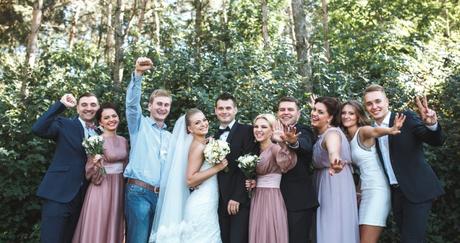People can often confuse the wedding dress codes for a particular wedding, especially when there are confusing terms like “casual” or “cocktail” on the invitation card. Formal attire may be the most common wedding collection that the guests wear, followed by semi-formals and casuals.
However, certain dress-codes are often passed on to the wedding guests through various invitation cards that underlie the dresses to which guests should stick.
One of the best ways to identify the type of clothes one should wear at a wedding is to research the venue where the function is hosted and their cultural and religious background.
Researching the venue can give the guests an idea of what they should wear and take hints from past wedding pics of the place, if available. Speaking of which, consider following these tips to make sure never to be wrongly dressed for a wedding invitation ever.
Make Sure To Follow These Tips For A Proper Wedding Wear Etiquette:

- Make sure to adequately research the place if the dress code is not indicated in the venue. Apart from indoor halls, the site can change from countrysides and beaches to barns or churchyards. Proper knowledge about the site can give the guest an idea about what to wear.
- Don’t be too casual when going to a wedding. Too much casual attire is a letdown when it comes to a grand affair like a wedding.
- Avoid wearing a completely white or single color outfit as much as possible. Unless it is specifically requested in the invitation, don’t wear all white clothes.
- Always be fully dressed when coming to weddings. Although it is evident, one can carry any extra pair of shoes or clothing in a purse or bag.
- Always learn to understand the different types of dress-codes mentioned in the invitation. If one doesn’t have an idea, looking up what the term means is a good option.
- Dressing, according to the time of the day, can be better for aesthetic purposes. Brighter colors go with functions that happen in daylight, and darker hues go with nighttime festivities.
- Always wear formal attire for destination weddings, even if it is at a beach. Switching to casual after the ceremony is what is usually preferred as a proper wedding attire etiquette.
- Always follow the theme of the wedding. There is nothing more uncomfortable than standing out in a crowd looking different from the wedding theme. Wedding themes are usually highlighted in the invitations.
- If no code is given or no theme is specified, always follow the traditional dress-code. Looking sharp in a wedding matters more than looking casual.
What To Wear For Weddings And Ceremonies:
Colour is an essential factor when picking out dresses. Nothing marks an Indian wedding like bright and joyous colors irrespective of the season or the venue.
Wedding collection for women usually consists of bright hues and tones and are usually encouraged with darker tones worn by men. Although black is not often encouraged during wedding ceremonies, wearing red is also not recommended as the bride typically wears red, white, or a mix of bright colors.
Since most Indian weddings have different cultures or blends, guests should familiarise themselves with the cultural dress-codes before purchasing a dress. Sarees are the most common option, followed by lehengas.
But as mentioned before, the place and cultures matter more. South Indians have different dressing styles for weddings compared to most North Indian weddings. However, being completely traditional depends on the guest as many modern Indian weddings see many pantsuits and stylish attire. Most marriages don’t usually specify a dress-code, and western clothing is often encouraged.
According to the culture and the traditional background, weddings can last for a few hours to a few days. Many Hindu weddings can last for a few days, with many festivities and occasions.
Christian weddings in India are usually a single-day event followed by a late-night party or function. Formal functions are generally the first part of all weddings, and guests are expected to wear formal attire during that time.
The casual festivities come after the formal events, and the attire changes to become more relaxed and flowy. Keep in mind that the more traditional the venue, like a temple or a religious place, the more conservative the dress-code.
Many wedding formalities can vary depending on the location, the culture, and the bride and groom’s religion, and the guests are expected to follow accordingly. Proper research and a little time to choose an appropriate attire can ensure that one looks great at weddings!

